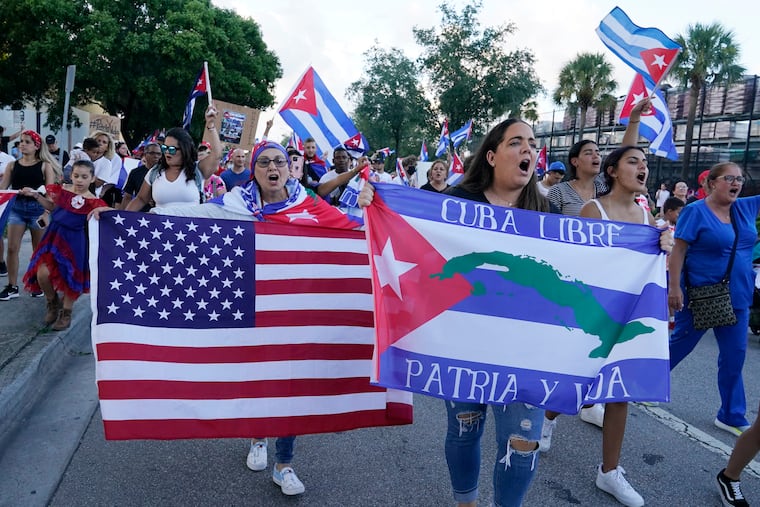Cuba’s protests are fueled by social media and artists’ history of resistance | Opinion
With greater internet access being inevitable in Cuba, these elusive exercises in democracy through virtual spaces may someday have a greater place in the country’s physical reality.

My eyes began to water as I scrolled through social media and witnessed countless images and video footage of Cubans taking to the streets in protest of the lack of freedom, food, and medicine on the island. As someone who studies contemporary art and activism, with a focus on Latin America, I wondered if this could be a turning point in Cuba’s history.
Hundreds of Cuban exiles and their relatives felt similarly, exemplified by the vast number of supporters gathering outside of Cuban embassies and on the streets internationally.
The ongoing protests are preceded by various political moments in Cuba that had freedom and democracy at their core. They’ve already led to some change: On Wednesday, the Cuban government temporarily lifted restrictions on travelers bringing food, medicine, and hygiene products to the country, seeming to acknowledge protesters’ voices.
» READ MORE: Cuba's leader lays some blame for protests on his government
Cuba’s recent widespread protests, occurring across the country’s many provinces, stand apart from the country’s other recent movements. Not only are they a call for greater freedoms on the island, but they are also a desperate cry for food and medicine, causes that greatly impact all of Cuba’s citizens. And they are intensely technologically mediated. Although internet access remains a scarce commodity for the majority of locals on the island, Cubans have adapted to the lack of connectivity through various means. Many activists and dissidents on the island text message entries, photos, and videos to friends abroad who can share the material on social media.
The current protests have been reinforced through these offline-online distribution networks, with many foreigners posting and reposting tweets, images, and videos sent from Cuba in support of the protesters and their demands. Additionally, some protesters have admitted that they found out about the events through social media.
Censorship remains deeply embedded in Cuba’s virtual landscape, and the island’s internet access was quickly mitigated when authorities began blocking Facebook, Instagram, and WhatsApp, among other applications, in response to the protests. While this made it difficult for international supporters to stay updated, already shared images continued to circulate, creating a strong case for the reposting of suppressed voices.
But understanding how Cuba got to this moment also requires looking at its recent history of resistance, often led by artists.
In 2018, President Miguel Díaz-Canel instated Decree 349 requiring all artists to obtain approval from the Ministry of Culture before operating in public or private spaces and asserts that businesses and individuals who hire artists without authorization may be sanctioned. Artists and activists responded with campaigns including the social media-driven “No al Decreto 349.” No al Decreto 349 deployed a hashtag, Facebook page, and open letters to Díaz-Canel garnering international support from artists, museums, and NGOs worldwide. Recent control tactics have attempted to thwart similar efforts. In July 2019, Cuba saw the application of Decree 370 “On the Computerization of Cuban Society,” which vaguely establishes several acts as violations, including “spreading information contrary to the common good, morals, decency, and integrity through public data transmission networks.”
Decree 370 can be seen as part of a broader agenda to limit freedom of expression, particularly given the proximity of its release to Decree 349. But several visual artists who opposed Decree 349, including Tania Bruguera and Ana Olema, used social media itself to resist Decree 370, posting images of themselves wearing masks with 370 written across them, raising awareness of the decree, and promoting the use of face masks amid COVID-19.
» READ MORE: Causes of the protests in Cuba
The increases in censorship tactics and other restrictive measures ultimately led to the formation of oppositional movements, including the San Isidro Movement, founded in 2018 and largely made up of visual artists, musicians, academics, and journalists. On Nov. 27, protesters assembled outside of Havana’s Ministry of Culture following a raid on the San Isidro Movement’s headquarters in response to hunger strikes taking place there. The protest ended when officials agreed to meet with demonstrators to discuss the release of detained independent artists.
In today’s protests, the connection between social media and in-person action is perhaps stronger than ever. Many protesters have gone missing since the events began, leading to the creation of a Facebook page titled “DESAPARECIDOS #SOSCuba,” which as of this writing has over 3,000 members. The page is filled with images and descriptions of missing people in the hopes of finding them, as well as a long list of names that demonstrates the severity of the protest’s repercussions. Although this platform is largely watched by individuals living abroad, it is difficult to deny that social media platforms have created an alternative space for dissenting ideologies, many focused on freedom of expression.
With greater internet access being an inevitable realization in Cuba, these elusive exercises in democracy through virtual spaces may someday have a greater place in the country’s physical reality. Even if the protests result in little to no immediate outcomes, they serve as evidence of the growing discontent toward Cuba’s policies and make it impossible to ignore a need for real change.
Katherine Mato is an assistant teaching professor of art history at Penn State Abington. Katherine holds a master’s degree in history of art and visual culture from the University of Oxford and a doctorate in Latin American studies from the University of Cambridge.